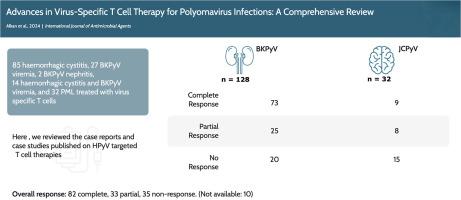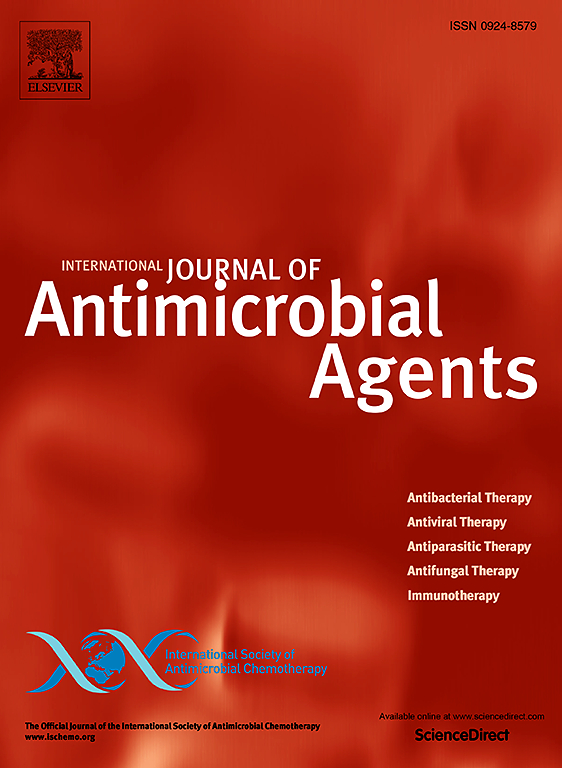多瘤病毒感染的病毒特异性 T 细胞疗法进展:全面回顾。
IF 4.9
2区 医学
Q1 INFECTIOUS DISEASES
International Journal of Antimicrobial Agents
Pub Date : 2024-09-07
DOI:10.1016/j.ijantimicag.2024.107333
引用次数: 0
摘要
多瘤病毒是一类小型、无包膜、双链 DNA 病毒,可感染包括人类在内的各种宿主。已知 BKPyV 可导致人类多瘤病毒相关性肾病(HPyVAN)、人类多瘤病毒相关性出血性膀胱炎(HPyVHC)和人类多瘤病毒相关性尿道癌(HPyVUC)等疾病。另一方面,JCPyV 可导致进行性多灶性白质脑病(PML),这是一种严重的中枢神经系统脱髓鞘疾病。PML 主要影响免疫力低下的人群,包括艾滋病毒感染者、某些免疫抑制疗法的接受者和移植患者。人类乳头瘤病毒感染的治疗方案一直很有限,但病毒特异性 T 细胞(VST)疗法的最新进展已显示出希望。虽然 VST 疗法在治疗 BKPyV 和 JCPyV 感染方面已显示出希望,但仍存在一些挑战。这些挑战包括:VST 的制备耗时且成本高昂、需要先进的生产设备,以及最佳细胞类型和输注频率的不确定性。据我们所知,有 85 名出血性膀胱炎患者、27 名 BKPyV 病毒血症患者、2 名 BKPyV 肾炎患者、14 名出血性膀胱炎和 BKPyV 病毒血症患者以及 32 名 PML 患者接受了 VST 治疗。完全应答、部分应答、无应答和无结果报告(NA)分别为 82 例、33 例、35 例和 10 例。总之,本综述强调了VST疗法作为一种治疗多瘤病毒感染的有前途的方法的重要性,并强调需要继续开展研究和临床试验,以完善和扩展这种创新的免疫治疗策略。本文章由计算机程序翻译,如有差异,请以英文原文为准。

Advances in Virus-Specific T-Cell Therapy for Polyomavirus Infections: A Comprehensive Review
Polyomaviruses are a group of small, non-enveloped, double-stranded DNA viruses that can infect various hosts, including humans. BKPyV causes conditions such as human polyomavirus-associated nephropathy (HPyVAN), human polyomavirus-associated haemorrhagic cystitis (HPyVHC), and human polyomavirus-associated urothelial cancer (HPyVUC). JC polyomavirus (JCPyV), on the other hand, is the causative agent of progressive multifocal leukoencephalopathy (PML), a severe demyelinating disease of the central nervous system. PML primarily affects immunocompromised individuals, including those with HIV, recipients of certain immunosuppressive therapies, and transplant patients. The treatment options for HPyV infections have been limited, but recent developments in virus-specific T cell (VST) therapy have shown promise. Although VST therapy has shown potential in treating both BKPyV and JCPyV infections, several challenges remain. These include the time-consuming and costly preparation of VSTs, the need for sophisticated production facilities, and uncertainties regarding the optimal cell type and infusion frequency. To the best of our knowledge, 85 patients with haemorrhagic cystitis, 27 patients with BKPyV viremia, 2 patients with BKPyV nephritis, 14 patients with haemorrhagic cystitis and BKPyV viremia, and 32 patients with PML have been treated with VST in the literature. The overall response results were 82 complete response, 33 partial response, 35 no response, and 10 no-outcome-reported. This review underscores the importance of VST therapy as a promising treatment approach for polyomavirus infections, emphasising the need for continued research and clinical trials to refine and expand this innovative immunotherapeutic strategy.
求助全文
通过发布文献求助,成功后即可免费获取论文全文。
去求助
来源期刊
CiteScore
21.60
自引率
0.90%
发文量
176
审稿时长
36 days
期刊介绍:
The International Journal of Antimicrobial Agents is a peer-reviewed publication offering comprehensive and current reference information on the physical, pharmacological, in vitro, and clinical properties of individual antimicrobial agents, covering antiviral, antiparasitic, antibacterial, and antifungal agents. The journal not only communicates new trends and developments through authoritative review articles but also addresses the critical issue of antimicrobial resistance, both in hospital and community settings. Published content includes solicited reviews by leading experts and high-quality original research papers in the specified fields.

 求助内容:
求助内容: 应助结果提醒方式:
应助结果提醒方式:


